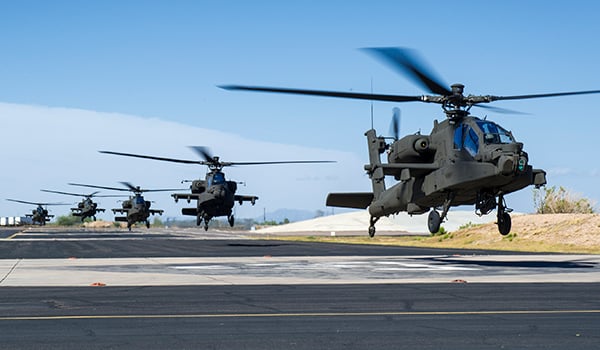
PEO Aviation / By BG Thomas H. Todd III: Aviation Family, as I enter my second year as the program executive officer for Army Aviation, we are faced with a demanding set of missions as well as a host of other challenges that impact the Aviation Enterprise in numerous ways.

U.S. Army Apache AH-64E helicopter pilots assigned to 1st Battalion, 229th Aviation Regiment, 16th Combat Aviation Brigade, 7th Infantry Division participate in Raptor Fury, a month-long exercise to validate 16th CAB’s mission readiness with the support of close to 1,500 7th ID Soldiers. / U.S. ARMY PHOTO
I, alongside a workforce of passionate acquisition professionals, stand ready to implement transformative strategies that will enable us to design the future combat aviation brigade (CAB) and provide a holistic, integrated set of capabilities to our combatant commanders and Soldiers in the field.
PEO Aviation is responsible for 30% of the Army’s major defense acquisition programs, which include Black Hawk, Apache and Chinook rotary wing platforms, fixed winged aircraft and unmanned aircraft systems, and is aligned with the Secretary of the Army’s modernization priority for Future Vertical Lift (FVL). This program will deliver 5th generation vertical lift aircraft to the Army and accelerate key disruptive technologies, bringing advances in speed and vertical mobility never before seen. Our workforce has honed years of acquisition, logistics and technological expertise that ensure we are developing and executing acquisition strategies to produce world class weapon systems, components and capabilities to retain overmatch against our near-peer adversaries now and in the future.
In this issue, you will have the opportunity to gain insights into the critical efforts our project managers (PMs) are leading to ensure our aviation platforms are modernized and equipped to meet the challenges faced in the field today, while preparing to integrate technological advancements that will serve the current and future fleet.
While modernization of our current platforms is a central tenet of our mission at PEO Aviation, we are simultaneously focused on innovative strategic goals with objectives to ensure we are postured to design, develop and deliver the capabilities of the future CAB. PM Aviation Systems provides the architecture for cross-cutting capabilities within the CAB, and an open systems architecture is crucial to providing holistic sets of capability to our Soldiers.
Initiatives
Our goal is to deploy a robust CAB Systems Integration Lab (SIL) to optimize sets of capabilities and materiel development solutions based on the operational needs of our combatant commanders (COCOM). The CAB SIL will enhance Aviation Enterprise synchronization efforts and enable the efficient prioritization and alignment of resources necessary to meet the demands of our Army’s multi-domain battle space.
Streamlined acquisition solutions are a fundamental component of achieving our goal to more rapidly field capabilities. Our acquisition process must be agile enough to respond to rapidly evolving threats, and fast enough to develop and deliver new capabilities within the arc of emerging threats. This past year has brought a watershed of long awaited Army modernization priorities and acquisition reform that make process streamlining even more meaningful and impactful to critical mission success. We have the chance to instill significant and lasting change not only in how we operate today, but more importantly, what we pass down to the future Army Aviation leaders of tomorrow.
We are leveraging the acquisition authorities given to us by Congress to the maximum extent practical, which are allowing for entry into flexible agreements with industry and academia, such as other transaction authorities (OTA). Furthermore, delegations of milestone decision authority are allowing for a transformation of the acquisition governance process and support a more tailored approach to developing acquisition strategies that will yield significant benefits to our Soldiers.
We are also expanding our application of the exchange and sale authority of non-excess, obsolete systems and components within our portfolio, which allows for reinvestment into modernized replacement equipment while avoiding significant disposal costs and alleviating a fiscal burden for the Army. To date, we have yielded over $150M of proceeds resulting from the exchange and sale of obsolete Black Hawk helicopters, while enhancing our partnerships with other government agencies and industry.
Organizational Changes
Over the past year, I have implemented some organizational changes to facilitate the successful execution of the PEO Aviation mission and vision and to more effectively and efficiently allocate resources. I welcomed an 0-6 COCOM liaison to the PEO AVN headquarters staff to ensure our focus is where it belongs – on the Soldier; I repurposed a G-5 “Futures Team” chartered with mapping science and technology (S&T) investments to our technology roadmap and Army Aviation branch priorities; and established a Strategic Initiatives Group (SIG) to lead the implementation of the PEO AVN Strategic Plan.
Our transformation reflects a progressive shift to strategy-based innovation and is underpinned by a refreshed focus on key measures which are aligned to tactical strategic actions. This is a promising time for Army Aviation and we are aggressively laying the technological framework for future CAB capabilities. I am looking forward to an incredibly productive year and have great confidence in our dedicated Aviation Team.
BG Thomas H. Todd III is the U.S. Army Program Executive Officer for Aviation located at Redstone Arsenal, AL
























